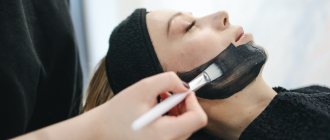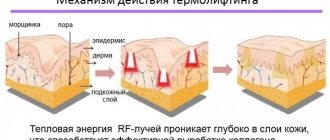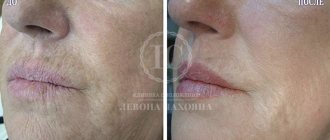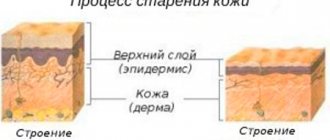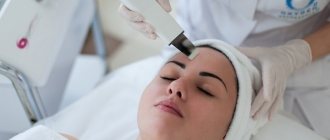Electrocoagulation is a technique that involves exposing the tissues of the human body to electric current. Previously, it was used only in surgery, but now the method has found application in cosmetology. Its essence lies in the fact that a probe heated by current welds a pathological area of skin or a neoplasm. This stimulates the clotting of blood proteins. As a result, the formation dries out and dies. Electrocoagulation in cosmetology is used to remove scars, dry calluses, warts, nevi, condylomas, and spider veins. But before you carry it out, you need to familiarize yourself with the contraindications.
…
In surgery and gynecology, the method of electrocoagulation has long been used for the purpose of dissecting tissue, stopping bleeding from small vessels during surgery, cauterizing cervical erosion, removing polyps and condylomas in the area of the external genitalia. Somewhat later, it began to be used in dermatology and cosmetology to remove warts, papillomas and other defects.
What is electrocoagulation and medical coagulator
The device produces direct and high-frequency alternating current. Under its influence, protein coagulates in tissues.
This allows you to quickly cut off the tumor and simultaneously cauterize the vessels. This eliminates the development of bleeding and infection.
In essence, a coagulator is a safe electric scalpel, which is used to perform pinpoint superficial operations without incisions.
The doctor works with electrosurgical high-frequency devices (ECHF). You can find other names: radio knife, radio scalpel.
Dermatologist Karin Litani
Types of effects of electrical impulses on the skin
The effect of high-frequency electric current on living epithelial cells is divided into several types:
- Physico-chemical impact – as a result, the physico-chemical balance inside the cell is disrupted.
- Thermal effects - after strong heating of the fabric, a burn forms on its surface.
- Electro-dynamic effect - blood, lymph or interstitial fluid is heated until a certain amount of steam is released, which provokes a sharp rupture of tissue.
- Biological effect - irritates healthy tissue around the damaged one, thereby accelerating the healing process.
The procedure for removing skin tumors is carried out using a special medical device - an electrocoagulator.
Indications for electrocoagulation
The procedure is prescribed in the presence (appearance) of formations on the skin or mucous membranes that are prone to degeneration and cause discomfort to a person.
INDICATIONS
- Moles, or nevi , are congenital or acquired formations on (above) the surface of the skin, filled with black, brown, red or purple pigment.
- Papillomas are benign neoplasms in the form of soft, dense tumors on a thin stalk, rarely on a broad base. In humans, they are most often of viral origin, but can also be congenital or may appear as a result of long-term chronic irritation. Papillomas have an uneven surface, in some cases the shape is similar to a cockscomb or cauliflower. They come in different shades from white to brown.
- Warts are a skin formation in the form of a papilla or nodule, caused by the human papillomavirus (HPV), transmitted through direct contact with a patient or through shared objects. The likelihood of the virus entering the body increases in the presence of skin damage (wounds, dermatitis, etc.).
- Actenic and senile keratomas are benign formations on the epidermis in the form of spots, growths, crusts and nodules. As a rule, they appear in women and men aged 50–65 years due to keratinization of skin cells. Due to their unaesthetic appearance, keratomas are removed, but sometimes they disappear spontaneously.
- Polyps are pathological neoplasms that grow above the mucous membrane of various organs: nose, stomach, intestines, bladder and gall bladder, cervix.
- Condylomas, or genital warts - like ordinary warts, appear after exposure (in this case, sexually) and activation of HPV in the body. The incubation period lasts from 2 - 3 months to several years. Growths appear on the external genitalia and mucous membranes. The virus is also transmitted through contact of the genitals with the oral cavity: it enters the lips, tonsils or palate. The risk of infecting a partner is highest in the first year of illness, then it decreases. The presence and proliferation of condylomas depends on the person’s immunity and lifestyle. Warts may disappear on their own or, conversely, may not respond to treatment. There is a possibility of their degeneration into a malignant tumor.
- Sebaceous gland adenomas are papules or nodules growing from glandular or ductal epithelium. They have a smooth surface and clearly defined edges. They come in flesh-colored, pink or pale yellow.
- Molluscum contagiosum is a pink or flesh-colored nodule that forms on the external genitalia, thighs, buttocks, or lower abdomen. They are distinguished by a hemispherical shape with a shallow dent in the center. When pressed, a cheesy plug emerges from the neoplasm. The nodules do not hurt or bother. Most often, they go away on their own six months after their appearance. Otherwise they are deleted.
- Erosion and cysts of the cervix - gynecologists call them “silent” pathologies, since nothing can bother a woman for years, but can cause infertility or oncology. During electrocoagulation of the cervix, the wounds on the mucous membrane are cauterized, and soon a new epithelium grows in this place.
- Vessels and dilated capillaries on the skin - for various reasons, they appear on the wings of the nose and cheeks and shine through the thinned goat, giving it an unhealthy reddish tint. Unlike the procedure for removing tumors, when treating vessels and capillaries, a course of electrocoagulation will be required lasting from 2 to 6 months. The result is the disappearance of the vascular network without a trace, the likelihood of its appearance if the doctor’s recommendations are followed is minimal.
- An ingrown nail (onychocryptosis) is a pathology in which the nail plate grows into the soft tissue on one or both sides of the nail. The technique of completely removing the plate without treating the growth zone is becoming a thing of the past. Today, after treatment with antifungal drugs (if necessary), it is enough to carry out electrocoagulation of the germinal zone. When the procedure is performed correctly, the nail plate narrows and the periungual fold decreases. The relapse rate with proper hygiene and correct choice is less than 1%.
Comparison of electrocoagulation with laser therapy
The use of laser in cosmetology, in contrast to electrocoagulation, allows one to influence pathological tissue with very high precision. There is no damage to surrounding healthy cells and no prolonged pain during the recovery period. The healing process occurs much faster, and the risk of the complications listed above is reduced many times. Using a laser, it is possible to treat rosacea and eliminate age spots.
However, when deciding which is better - electrocoagulation or laser, the following factors should be taken into account:
- The optimal use of laser therapy is mainly the treatment of defects that are at the same level with the skin surface (seborrheic keratosis, hemangiomas, spider veins, pigmented spots, small flat papillomas on a wide base, etc.);
- high cost of laser treatment.
Despite the availability of a more advanced laser method, electrocoagulation in cosmetology remains a universal and popular method due to its effectiveness, safety, ease of use and low cost of equipment and procedures.
How is the procedure performed?
Electrocoagulation of the skin is carried out using a mono or bipolar electrode in the form of a needle, knife, loop or ball - depending on the type of tumor.
Preparation for removal involves disinfecting the surface of the problem area and applying local anesthesia. When eliminating minor defects, there is no need for anesthesia.
The current passing through the tool nozzle locally heats the tissue at the base of the formation and destroys the protein.
The entire protruding part is rejected and a neat hemorrhagic crust forms on the surface of the epidermis or mucous membrane.
As a rule, the mini-operation lasts no more than a minute, after which the patient can return to normal activities.
During the procedure, the doctor can remove up to 30 small tumors located in one area.
Dermatologist Karen Beasley
The scab that forms at the cut site should be treated with a special solution for the first time.
You cannot remove the crust: with a high degree of probability, the open wound will fester, and an ugly scar will later form in its place. The complete healing process lasts from 8 to 12 days. The scab will fall off on its own, leaving virtually no mark on the skin.
When the vascular mesh is removed, a thin needle electrode is used. The doctor pierces the skin surface with it. Anesthesia is required.
Dermatologist Karin Litani
Before performing electrocoagulation, you should consult a specialist. Depending on the location of the tumor, this may be an oncologist, gynecologist, dermatovenerologist, or otolaryngologist.
The doctor will conduct an examination, determine the type of formation using dermatoscopy (hardware examination) and evaluate the possibility of its removal.
Electrocoagulation of ingrown toenails is always performed under anesthesia. After the operation, the patient is prescribed analgesics and recommended to remain in bed for 24 hours.
Dressing is performed as necessary. Complete healing requires 2–3 weeks, during which physical activity should be limited.
What is this procedure?
One of the highly effective treatment procedures is electrocoagulation of vascular networks. Pathological vascular neoplasm is eliminated by cauterization or sealing of tissue altered by pathology. For these purposes, the use of high-frequency currents (direct or alternating) is implied.
The procedure is widely used not only in medicine, but also in cosmetology. Since it not only removes telangiectasia from the epidermis, but improves blood circulation and metabolism, which normalizes the condition of the skin.
Removal of vessels that have lost their elasticity by electrocoagulation has the following effects on the tissue:
- Biological.
During the procedure, simultaneous death of pathological tissue and stimulation of undamaged tissue occurs, followed by regeneration; - Physico-chemical.
Physico-chemical bonds that are responsible for the attraction of cells are destroyed; - Thermal.
Causes burns because living tissue is heated to a high temperature; - Electrodynamic.
Leads to a change in structure, i.e. rupture of cells and tissues under the action of steam generated by heating blood, interstitial and lymphatic fluid.
Expert opinion
Such a wide spectrum of action of electric current leads to the removal of blood from deformed capillaries and subsequent gluing of their walls. In this regard, such capillaries are excluded as a link from the microcirculatory bloodstream, and accordingly cease to participate in the blood flow. At the same time, the external condition of the skin takes on a healthy appearance - the vascular pattern disappears.
Vascular surgeon, phlebologist
Osipova Ekaterina Yakovlevna
Rehabilitation after electrocoagulation of tumors
During the first week, skin wounds are treated with an antiseptic. This may be a solution of potassium permanganate. Treatment must be carried out daily. During this period, visiting the pool, sauna and bathhouse is not recommended.
Prolonged exposure to the sun should be avoided and the surgical site should not be exposed to ultraviolet light. Do not rub the treatment area with a hard washcloth.
Dermatologist Marty Gidon
The postoperative crust is a natural barrier against microorganisms. Its removal, as well as accidental or intentional mechanical impact on the treated area of skin can provoke the formation of scar tissue at the site of the cut.
If the epidermis in the area of electrocoagulation changes color or any other changes are observed, you should immediately consult a doctor.
Foot skin care after the procedure
What to do after electrocoagulation? What should be the care for the skin of the lower extremities? Indeed, foot skin care is of great importance after the procedure. The patient will receive the necessary recommendations from the attending physician. In general, care procedures are simple. The area exposed to high frequency current should be treated. Initially, it will be an antiseptic solution. Then ointments and creams can be prescribed that will normalize blood flow, tone veins and prevent capillary fragility. "NORMAVEN®" foot cream contains 12 natural ingredients that act in these directions. Thanks to vitamins A and E, the regeneration processes of the skin of the legs will be accelerated, and arnica and lingonberry extracts guarantee a capillary-strengthening and anti-inflammatory effect.
What is electrocoagulation?
Contraindications (10 prohibitions)
Electrocoagulation should not be performed if one or more of the following factors are present.
CONTRAINDICATIONS
- malignant neoplasms;
- herpes in the active stage;
- blood diseases and blood clotting disorders;
- allergy to anesthetics;
- individual intolerance to electrical procedures;
- presence of a pacemaker;
- tendency to form keloid scars;
- inflammatory process in the treatment area;
- any somatic diseases in the acute phase;
- pregnancy and breastfeeding.
The procedure costs 350-1200 rubles. It all depends on the amount of work.
Progress
The procedure is performed by a qualified doctor in a clinical setting. Only in this case can a positive outcome be expected.
The sequence of electrocoagulation:
- The skin area is disinfected and dried with a sterile cloth.
- If the formation is small, then anesthesia is not used. For large areas of work, local anesthesia is performed.
- The tumor is removed with one of the attachments - an electric knife or a loop. If a papilloma is removed, its head is grabbed with tweezers, and the leg is quickly cauterized.
- The duration of the manipulation depends on the specifics of the skin defect - from a few seconds (papilloma 2-3 mm) to 15 minutes. If there are many formations, then the treatment can be divided into several procedures.
- A brown crust remains at the site of electrode impact. It is treated with a solution of potassium permanganate.
- After peeling off the crust, a pink spot remains, which then becomes equal in color to the rest of the skin.
If necessary, the removed tissue is sent to the laboratory for histological examination. This is an important step when removing any moles (nevi), papillomas and other suspicious growths. It is important to diagnose the presence of malignant cells in time.
Alternative Methods
There are other methods for removing skin tumors:
- Laser destruction. A laser beam is used, which non-contactly removes papilloma or other formation. Healthy tissues are not affected. Recovery is faster.
- Cryodestruction. In this case, liquid nitrogen is used, which freezes and resolves the tissue.
- Radio wave removal. During the procedure, the doctor uses the Surgitron device. Removal occurs due to radio waves.
- Surgical removal. The doctor uses a regular scalpel.
Removal by electrocoagulation: pros and cons of the procedure
The procedure has a number of advantages compared to other procedures for eliminating vascular patterns. But, at the same time, there are a number of shortcomings. Let's look at each aspect in more detail.
Advantages:
- simplicity and efficiency;
- minimal trauma;
- the potential possibility of performing the procedure on any part of the body;
- lack of special patient preparation;
- conducting a session on an outpatient basis;
- low frequency and short duration of sessions;
- visual control of the depth and scale of impact;
- the skin recovers quickly;
- a small number of side effects and contraindications;
- eliminating the risk of infection.
Flaws:
- painful sensations;
- use of local anesthesia;
- presence of a healing period;
- involvement of healthy tissue in the thermal reaction.
Consequences of electrocoagulation
Expert opinion
- Cosmetologist
- Surgeon
Anna Avaliani
practicing cosmetologist
Typically, patients' skin recovers within 10 days. This is longer when compared with laser destruction, when recovery takes up to 7 days. After radio wave removal, 3 days are required for rehabilitation. But for the delicate skin under the eyes, I would suggest laser treatment rather than the use of electrocoagulation.
Sheila Nazaryan
plastic surgeon
This method has its pros and cons. Many doctors advise paying attention to laser techniques, but they are more expensive, which is a compelling argument to lean towards electrocoagulation.
Possible complications
Complications after electrocoagulation are extremely rare. There is a risk of a reaction to anesthetic drugs. Problems can also arise if wound care recommendations are not followed. If you tear off the crust (scab) ahead of time, there is a possibility of infection getting into it, followed by suppuration. It can also cause scar formation. Normally, a scar on the skin remains only when the formation has a deep root. In other cases, everything ends with the skin healing without any negative consequences.
Reviews
NATALIA, 28 YEARS OLD:
“I had a large mole on my neck for a long time.
In principle, she did not interfere with life, but I constantly touched her with the chain and collar of my clothes. One day I accidentally pulled the collar of my shirt particularly hard, which I thought was torn off. I was terribly scared. I've read all sorts of horror stories about cancer and how you shouldn't damage it. I decided that I should try to delete it. I live in a small town, so I signed up for such a serious procedure at a clinic in the regional center.
At the consultation, the doctor carefully examined my long-suffering mole and said that it could be removed right now. He gave an anesthetic injection, and after 5 minutes I cut it off with a small device.
My happiness knew no bounds. And when the results of histology of the cut tissue came back, I felt better. Now I’m thinking, why did I suffer for so long? It cost little money, but the result is priceless. Now at least wear a choker or wear a golf.”
ALLA, 39 YEARS OLD:
“I treated cervical erosion with electrocoagulation.
Somehow nothing was bothering me, so I delayed visiting the gynecologist and kept putting it off. When I finally got checked and found out about the erosion, I panicked. Thanks to the doctor I saw, she did everything carefully. The mucous membrane has recovered. I’m thinking of going to remove the papilloma on my back in the same way.”
SERGEY, 28 YEARS OLD:
“I’ve never had warts, but six months ago they started spreading all over my arms.
Celandine and this all didn’t help. I decided that I needed to make an appointment with a doctor, otherwise I would be embarrassed to take a girl’s hand. In principle, I knew what I was getting into, because once in college I even wrote an essay about electrocoagulation, how it works and where it is used.
There were a lot of warts, they were removed in two times. The palms and fingers looked terrible, all covered in dark crusty spots. But when they healed, I felt like a different person. So far everything is clean, not a single new wart.”
Now you understand what electrocoagulation is. It remains one of the best methods for combating tumors on the skin and mucous membranes.
The procedure is effective, safe and affordable. In just one session you can get rid of unaesthetic papillomas and warts, as well as formations prone to degeneration.
Contraindications to electrocoagulation
- intolerance to electrical procedures and drugs for local anesthesia
- blood clotting disorder
- suspicion of a malignant nature of the skin formation
- acute infectious diseases
- herpes skin rash
- presence of a pacemaker
- rapid growth of benign neoplasms
- systemic blood diseases, leukemia
- increased skin sensitivity to light (photodermatoses)
- endocrine diseases (decompensated diabetes mellitus, etc.)
- diseases of the cardiovascular system (crisis course of arterial hypertension, heart and pulmonary failure stage 3)
How many procedures will be required?
An important advantage of removing papillomas using electrocoagulation is the ability to solve the problem in one session.
This is true for small tumors with a thin stalk located in accessible areas of the body.
There are situations when the procedure does not remove the growth immediately.
This is possible if:
- papilloma on a flat base, deeply located;
- relapse occurred after resection;
- there are large numbers of growths on the patient’s skin (papillomatosis).
In these situations, electrocoagulation is carried out in several sessions, the number and frequency of which are determined by the attending physician. It is possible to choose another method of influencing the area of skin covered with tumors: for example, laser or radio wave resection. For large growths, surgical removal with a scalpel is used.
Treatment of papillomas is not limited to one visit to the surgical clinic. The patient needs to undergo a PCR test to determine which strain of HPV is causing the growths. If the diagnosis shows an oncogenic type, the doctor will prescribe drug treatment to avoid adverse consequences - cancerous tumors.
Therapy may include taking antiviral drugs (for example, Isoprinosine, Panavir), immunomodulators in tablets or injections (for example, Lykopid), vitamin complexes. Additionally, correction of the daily routine will be required: ensuring sufficient rest and quality sleep, regular walks in the fresh air, and a balanced diet.
Condylomas and methods of their treatment
Condylomas (genital papillomas) are cone-shaped growths on the skin. These tumors usually indicate a viral infection that is sexually transmitted. There are five effective methods for removing condylomas: surgical, cryodestruction, laser, radiosurgery and electrocoagulation.
In the most difficult cases, electrocoagulation is used; it is performed under local anesthesia. The procedure takes 10-20 minutes, the recovery period is about two weeks.
You can learn more about the removal of papillomas using electrocoagulation at an appointment with a specialist. Registration for a consultation is available on our website https://www.dobrobut.com/.
In what cases is it contraindicated?
There are cases when electrocoagulation has contraindications. The reason for this is possible negative consequences in the form of deterioration of the condition, as well as other clinical cases.
It is not recommended to apply for the procedure to patients who have the following diseases and pathologies:
- acute reaction of the body to the current;
- allergy to disinfectants;
- problems with blood clotting;
- the presence of viral diseases;
- blood sugar problems;
- psychical deviations;
- cancer diseases.
Also, those who have implants or a pacemaker should not sign up for a session.
Electrocoagulation of blood vessels on the face
The procedure, which helps get rid of dilated capillaries on the face, is carried out using a device that generates low-frequency electric current. As a rule, one session of electrocoagulation is performed in this area. If necessary, a repeat session can be scheduled - but not earlier than after 10 days.
Stages of electrocoagulation of blood vessels on the face:
- the skin area is treated with a disinfectant solution, then anesthesia is performed with lidocaine;
- the doctor “cauterizes” the vessels with a needle guide;
- After the procedure, the skin is treated with a disinfectant solution and corticosteroid ointment is applied (to prevent complications).
Electrocoagulation of condylomas will be discussed further.
Prevention of spider veins
To prevent the appearance of spider veins, you must adhere to the following recommendations:
- Use only high-quality cosmetics. It is advisable to use organic products. Particular attention should be paid to the expiration date of the product.
- Do not wash your face with soap, because after such exposure the skin lacks oxygen and irritation appears.
- Avoid exposure to high temperatures.
- Wash your face first with warm water and then with cold water.
